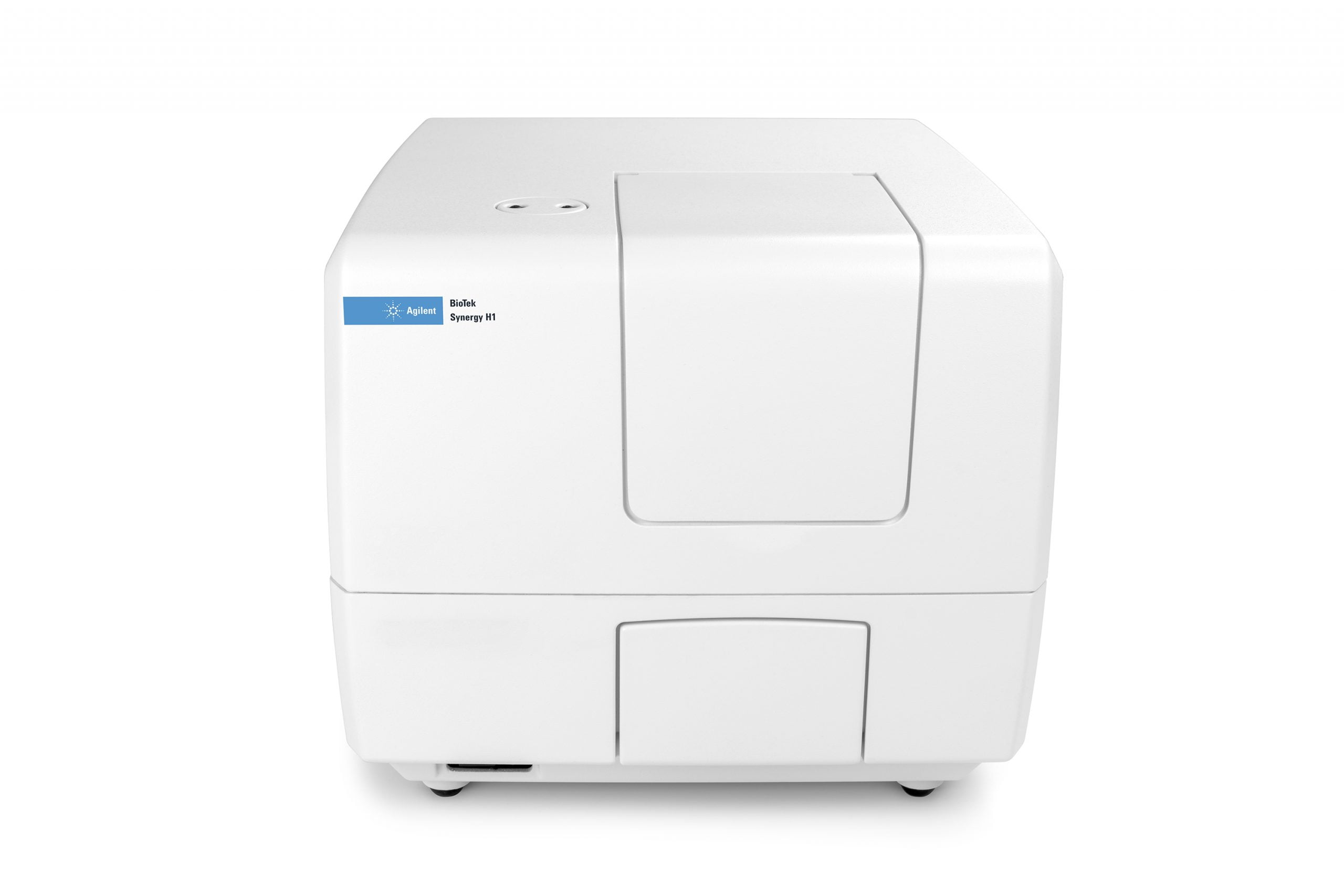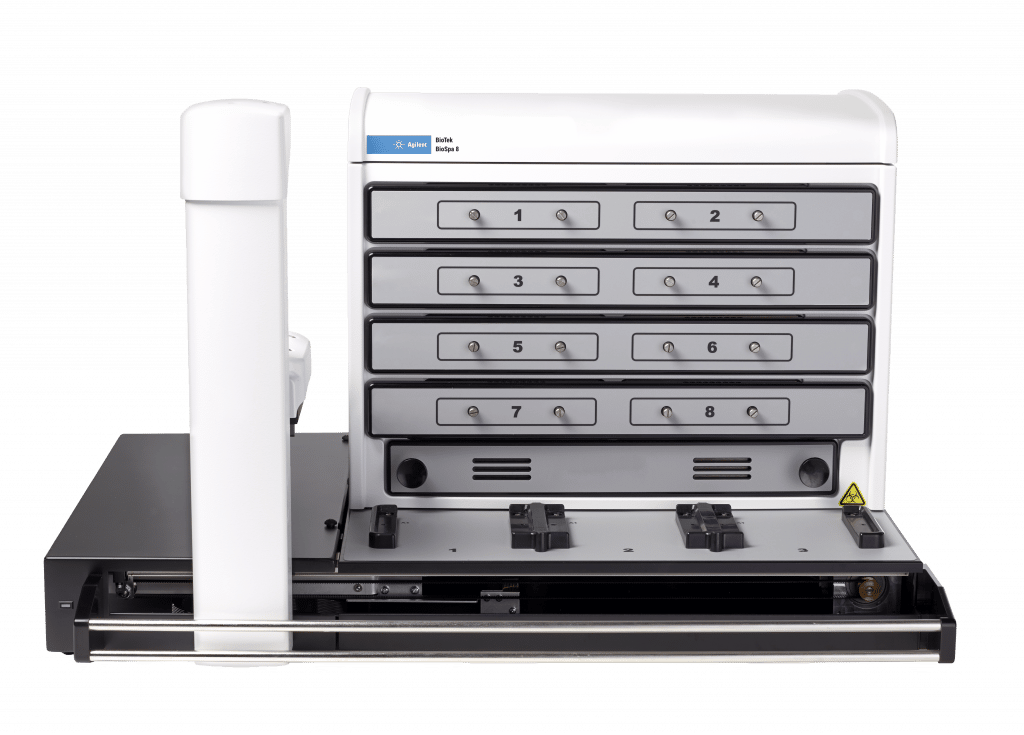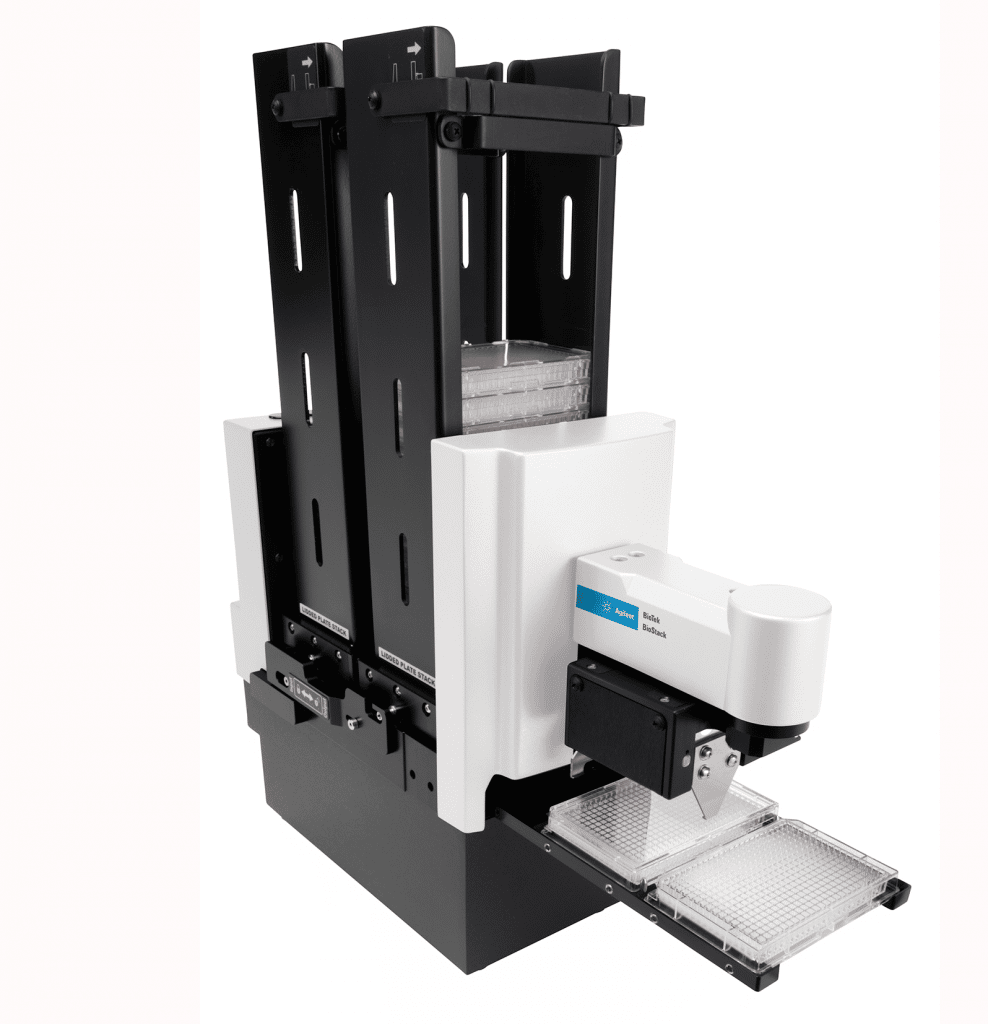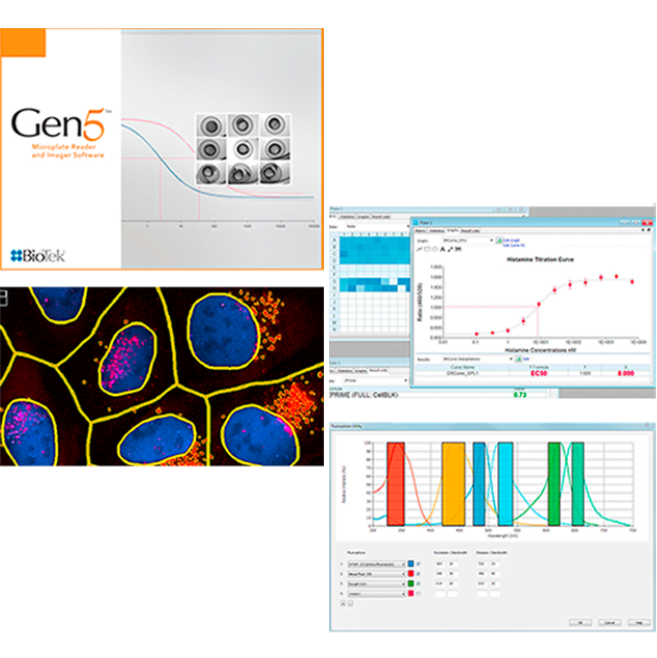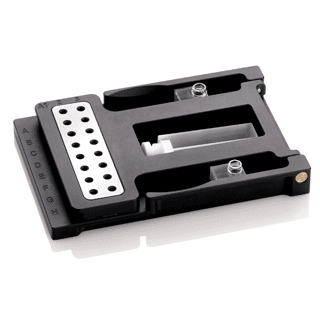BioTek Synergy H1
Information
Synergy™ H 1 is a configurable multi-mode microplate reader. You can choose monochromator-base optics for flexibility, filter-based optics for sensitivity, or both… Agilent’s patent Hybrid Technology™ offers high-performance and applications versatility in a modular platform to expand as your laboratory’s needs change. Top and bottom fluorescence intensity, UV-visible absorbance and luminescence detection are available to meet many life science research requirements.
- Cost-effective hybrid offering excellent sensitivity, flexibility and value
- Modular and upgradable: choose the modes you need now, add as needs change
- Patented Hybrid Technology: sensitivity of filters and flexibility of monochromators
- Low volume (2 µL) dsDNA quantification with Take3 Micro-Volume Plates
- Live cell assay friendly with temperature control and CO2/O2 control
“At the end of last year we purchased four Synergy H1 readers in order to get a maximum of uniformity within the devices.
As a result, when running projects we have multiple options. ”Patrick Janssen, Scientist Fermentation at NIZO
-
Specifications
GENERAL Detection modes UV-Vis absorbance Fluorescence intensity Luminescence Fluorescence polarization Time-resolved fluorescence Read methods Endpoint, kinetic, spectral scanning, well area scanning Microplate types 6- to 384-well plates Other labware supported Petri and cell culture dishes Take3 Micro-Volume Plates Temperature control 4-Zone™ incubation to 45 °C with Condensation Control™ +0.2 °C at 37 °C Shaking Linear, orbital, double orbital Software Gen6 Data Analysis Software Gen5 Secure for 21 CFR Part 11 compliance (option) Automation BioStack and 3rd party automation compatible BioSpa 8 Automated Incubator compatible CO2 and O2 control (option) Range: 0 – 20% (CO2); 1 – 19% (O2) Control Resolution: +0.1% (CO2 and O2) Stability: +0.2% at 5% CO2; +0.2% at 1% O2 Models for both CO2 and O2 or CO2 only are available ABSORBANCE Light source Xenon flash Detector photodiode Wavelength selection monochromator Wavelength range 230 – 999 nm, 1 nm increments Monochromator bandwidth 4 nm (230-285 nm), 8 nm (>285 nm) Dynamic range 0 – 4.0 OD Resolution 0.0001 OD Pathlength correction yes Monochromator wavelength accuracy ±2 nm Monochromator wavelength repeatability ±0.2 nm OD accuracy <1% at 2.0 OD <3% at 3.0 OD OD linearity <1% from 0 to 3.0 OD OD repeatability <0.5% at 2.0 OD Stray light 0.03% at 230 nm Reading speed (kinetic) 96 wells: 11 seconds 384 wells: 22 seconds FLUORESCENCE INTENSITY Light source Xenon flash Detector PMT for monochromator system PMT for filter system Wavelength selection Quad monochromators (top/bottom) Filters (top) Wavelength range Monochromators: 250 – 700 nm (850 nm option) Filters: 200 – 700 nm (850 nm option) Monochromator bandwidth Fixed, 16 nm Dynamic range 7 decades Sensitivity Filters: Fluorescein 0.25 pM (0.025 fmol/well, 384-well plate) Quad Monochromator: Fluorescein 2.5 pM (0.25 fmol/well, 384-well plate) – top Fluorescein 4 pM (0.4 fmol/well, 384-well plate) – bottom Reading speed (kinetic) 96 wells: 11 seconds 384 wells: 22 seconds LUMINESCENCE Wavelength range 300 – 700 nm Dynamic range >6 decades Sensitivity Monos: 20 amol ATP (flash) Filters: 10 amol ATP (flash), 100 amol (glow) FLUORESCENCE POLARIZATION Light source Xenon flash Detector PMT Wavelength selection Filters Wavelength range 280 – 700 nm (850 nm option) Sensitivity 1.2 mP standard deviation at 1 nm fluorescein TIME-RESOLVED FLUORESCENCE Light source Xenon flash Detector PMT Wavelength selection Quad monochromators (secondary mode) Filters (top) Wavelength range Filters: 200 – 700 nm (850 nm option) Sensitivity Filters: Europium 40 fM (4 amol/well, 384-well plate) Monos: Europium 1200 fM (120 amol/well, 384-well plate) REAGENT DISPENSERS Supported detection modes All modes Number 2 syringe pumps Supported labware 6- to 384-well microplates, Petri dishes Dead volume 1.1 mL with back flush Dispense volume 5 – 1000 µL in 1 µL increment Dispense accuracy ±1 µL or 2% Dispense precision <2% at 50-200 µL PHYSICAL CHARACTERISTICS Power 130 Watts max. Dimensions 15.4″W 18.6″D 12.9″H (39.1 x 47.2 x 32.8 cm) Weight 50 lbs (22.5 kg) REGULATORY Regulatory CE and TUV marked. RoHS Compliant. Models for In Vitro Diagnostic use are available. -
Software
Gen6 software controls all Agilent BioTek automated microplate readers, configuring system and data collection parameters, analysis and a variety of reporting and exporting features. One-click export to Excel® makes it fast and easy to export displayed data.
Gen5 Secure software is available for GxP compliant laboratories with features that support 21 CFR Part 11 rules. -
Micro Volume Plates
Micro-volume quantification is fast and easy with the Take3™ and Take3 Trio Micro-Volume plates, used in your BioTek microplate reader. Measure multiple 2 µL samples at a time, without diluting and without needing specialized equipment. Pre-programmed nucleic acid and protein protocols in Gen6 make quantification fast and easy.
- Low volume 2 µL nucleic acid and protein quantification
- Pre-programmed protocols in Gen6 Software
- Absorbance and fluorescence detection
- Easy, wipe-off maintenance
- Read 2 µL microspots, BioCells or standard cuvettes
-
Robotics
Agilent’s robotic instruments can help automate workflows in your laboratory. Many life science workflows benefit from expanded automation, for increased throughput or process efficiency. Agilent offers unique automation solutions that integrate with our microplate washers, dispensers, readers and imagers.
BioStack is a compact stacker that offers fast plate exchange options for 50 plates or more, and patented plate de-lidding and re-lidding with BioStack 4 .
BioSpa 8 Automated Incubator links Agilent readers or imagers together with washers and dispensers for full workflow automation of up to 8 microplates. Temperature, CO2/O2 and humidity levels are controlled and monitored through the BioSpa software to maintain an ideal environment for cell cultures during all experimental stages.
-
Features
Cost-effective hybrid offering excellent sensitivity, flexibility and value
Agilent’s Hybrid Technology offers affordable multi-mode detection without compromising on performance. Sensitive filter-based optics, flexible monochromator-based optics, or both – on one instrument, powered by Gen6 software for data collection and analysis.Modular and upgradable: choose the modes and modules you need now, add as needs change
With six different base configurations to choose from, Synergy H1 is an affordable, upgradable solution to address your laboratory’s research needs now and well into the futurePatented Hybrid Technology™: sensitivity of filters and flexibility of monochromators
Synergy H1’s hybrid optical design offers filter-based fluorescence optics for high transmission and high sensitivity, while the available monochromator optics offers convenience and assay flexibility. Multiple fluorescence measurement modes include fluorescence intensity, time-resolved fluorescence and fluorescence polarizationLow volume (2 µL) dsDNA quantification with Take3 Micro-Volume Plates
The Take3 Micro-Volume plate extends the Synergy H1 capabilities beyond standard microplate reading, by measuring up to 48, 2 µL samples at one time for rapid nucleic acid and protein quantification. Absorbance and fluorescence measurements are quick and easy, no additional instrumentation is required!Live cell assay friendly with temperature control and CO2/O2 control
Synergy H1 offers temperature control to 45 °C, plus linear and orbital shaking. Expand the applications base to live cell assays by adding the CO2/02 controller or the dual reagent injector for quick inject/read processes.Gen6 Data Analysis Software; Gen5 Secure for 21 CFR Part 11 compliance
Gen6 Microplate Reader and Imager Software doesn’t compromise on usability or data analysis performance – protocol creation is intuitive and flexible, and the data analysis capability rivals standalone packages. For the GxP lab, Gen5 Secure software offers features to help comply with 21 CFR Part 11, including electronic signature, data security and multiple level permissions.
Brochures
Application notes
Please login to be able to see the application notes.
